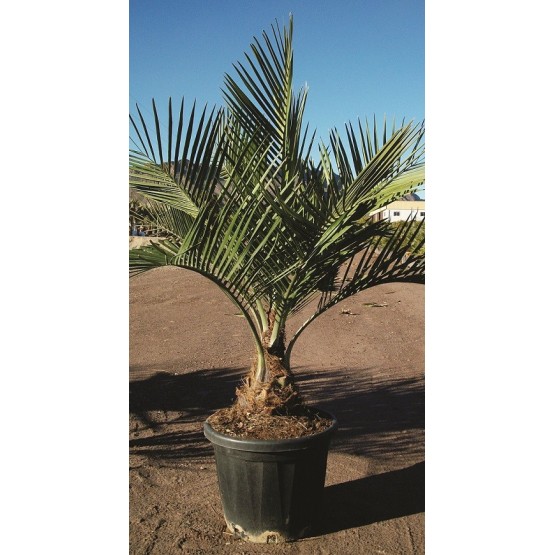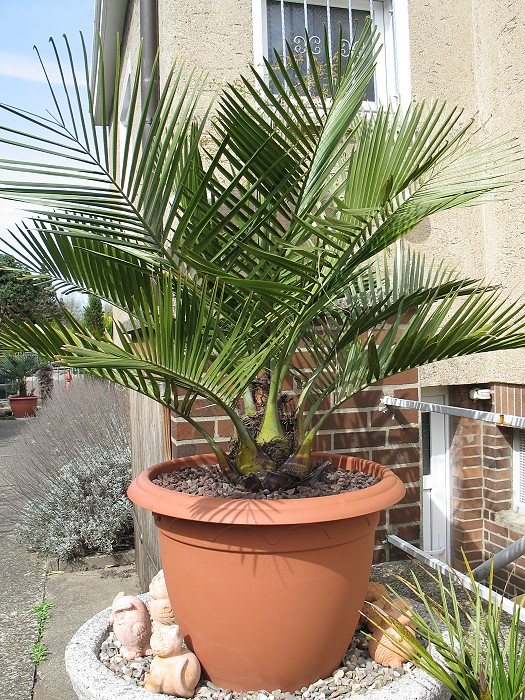
Jubaea chilensis Honigpalme kaufen Der Palmenstadl für mediterr, 199,00
Jubaea chilensis is the worlds cold hardiest feather palm, it is also the second most massive palm tree on the planet. Extremely hardy , taking cold to beyond -10C , there are mature specimens in Torquay. Capable of shrugging off all but the severest winter weather , with a little protection during rare severe weather events they can be grown.

Jubaea Chilensis
Jubaea chilensis requires sun and good drainage, but otherwise this slow growing palm will grow unprotected throughout much of the UK. Jubaea chilensis can grow to a mighty height and width which could outgrow its space. However, it is a slow growing palm, taking as long as 10 to 20 years for a trunk to form, and up to 60 years for it to.

Jubaea chilensis
Beschreibung: Jubaea chilensis, die Honigpalme ist die einzige Fiederpalme die auch bei uns frei ausgepflanzt werden kann. Substrat: kommt mit fast allen nicht zu humusreichen Böden zurecht. Wasser: gering Standort: sonnig Frostverträglichkeit: bis -15°C Wachstum: langsam Überwinterung: sehr frostresistent, sollte aber frei ausgepflanzt in kalten Regionen mit einem Winterschutz versehen.

Jubaea Chilensis Chileense wijnpalm GreenID
Jubaea chilensis (Chilean wine palm or Chile cocopalm) is the sole extant species in the genus Jubaea in the palm family Arecaceae. It is native to southwestern South America, where it is endemic to a small area of central Chile, between 32°S and 35°S in southern Coquimbo, Valparaíso, Santiago, O'Higgins and northern Maule regions. It was.

Jubaea Chilensis 350cm Winterhart bis 20 Grad Premium Qualität 100 cm Stamm VIP Kaufen bei
Description of Jubaea chilensis. The Chilean wine palm is a massive palm with an imposing trunk (up to 5 m in diameter and 25 m in height in its native habitat), but a slow-grower. A few centennial palms can be admired in Brittany, on the French Riviera, and even in Great-Britain. Its leaves are pinnate, like those of the coconut palm, with a.

Jubaea Chilensis
MyPalmShop has various Jubaea chilensis sizes available. You can sometimes even find rare hybrids. Origin of Jubaea. Jubaea originates in Chili. You used to be able to find millions of this palm tree all over this South American country, but their numbers have decreased significantly over the past years. You can find about 100.000 specimens.
.jpg?_=170cefd4630)
Honigpalme Jubaea chilensis die 10 wichtigsten Kauf und Pflegehinweise
Jubaea is a genus of palms with one species, Jubaea chilensis, commonly known in English as the Chilean wine palm or Chile cocopalm, and palma chilena in Spanish. It is native to southwestern South America and is endemic to a small area of central Chile between 32°S and 35°S in southern Coquimbo, Valparaíso, Santiago, O'Higgins, and northern Maule regions.
-1920w.jpeg)
Jubaea Chilensis
J. chilensis is a slow-growing palm which can reach 25m, with a single, scarred and cracked grey trunk and leaves up to 5m long formed of many very narrow, rigid, folded, yellow-green to dark green leaflets. Small, bowl-shaped, dull purple and yellow flowers are produced in summer in sprays up to 1.5m long, followed by woody, yellow fruit.

Jubaea chilensis Honigpalme kaufen Der Palmenstadl für mediterr, 199,00
Jubaea chilensis is one of the most awesome landscape palms in cultivation and an easy and hardy palm as well. The following article is an introduction to this amazing tree and how to grow it. This palm, as the name suggests, is native to Chile where it once grew in huge numbers. Today the palm is protected so it's making a comeback, but years.

JUBAEA CHILENSIS, Chilean Wine Palm. Free UK Delivery!
Blumenerde kaufen: Die Jubaea chilensis gedeihen in handelsüblicher Blumenerde auf Kompostbasis. Der pH-Wert ist auf der Verpackung angegeben und sollte innerhalb der tolerierten Werte liegen. Bei falschem pH-Wert des Substrats wird sich die Jubaea chilensis nicht gesund entwickeln können. Die einfachen Blumenerden aus dem Baumarkt.

Jubaea chilensis Medipalm Viveros
Jubaea Travels to Europe (1840s-1850s) Sometime between 1843 and 1846, Jubaea chilensis arrived at the Royal Botanic Gardens, Kew, where it thrived in the greenhouses. In the 1870s, a specimen in a tub was displayed outside Kew's main gate. Later, that palm was planted in the Temperate House, where it flowered and fruited for the first time.

Jubaea chilensis (Honigpalme) Stamm Ø40cm TopfØ80cm Höhe240cm Palmenhandel
Description. Jubaea chilensis the well known 'Chilean Wine Palm' is perhaps the most revered by collectors palm suitable for cultivation in cooler regions due to it's remarkable hardiness and adaptability growing very successfully here but unfortunately still rarely available to gardeners. You might ask why this magnificent 'feather.

Jubaea Chilensis Forsale For Sale PalmTalk
The Jubaea chilensis, also known as the Chilean wine palm or Chile cocopalm, is a unique and fascinating species of palm tree native to southwestern South America. It is endemic to a small area of central Chile, specifically between 32°S and 35°S in southern Coquimbo, Valparaíso, Santiago, O'Higgins, and northern Maule regions..

Palmiers Prestige vente de palmiers et cocotiers d'extérieurs
Jubaea chilensis is a slow-growing feather palm. It can get very old and in old age is one of the biggest palms in the world. I own a juv. A Jubaea seedling with two strap leaves survived -2 F in Bellevue WA, with its only protection being that it was sbmerged in one foot of.

Jubaea chilensis Honigpalme kaufen Der Palmenstadl für mediterr, 199,00
Jubaea chilensis is a single-trunked, pinnate-leaved palm growing to 20-25 m tall. The trunk is the stoutest of any palm, commonly a metre diameter at the base, sometimes up to 1.3 m diameter, often widest in the upper part of the trunk, with smooth grey bark. The dark green pinnate leaves are 3-5 m long, with pinnae to 30-50 cm long closely.

Jubaea chilensis
Die Jubaea chilensis kann nur in milden Regionen den Winter überstehen, wenn Sie also eine Honigpalme kaufen und im Garten anpflanzen möchten, sollten Sie dies unbedingt berücksichtigen. Abgesehen davon sollten Sie den Standort gut auswählen, um der Palme die Überwinterung zu erleichtern.